- en
Your cat's breath is getting worse, or perhaps they seem hesitant to eat their dry food. What could this mean? It may mean your cat needs their teeth cleaned and possibly some teeth removed.
This InfoRx explains what a dental cleaning is and when it's needed. Additionally, it will help explain the reasons behind why some teeth need to be extracted and how you can help your cat feel comfortable afterward.
Quick Links
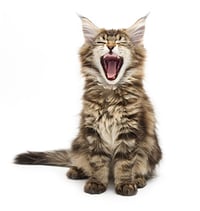
Kittens are born without teeth. When kittens are between 2 to 4 weeks of age, their teeth begin to come in. The first teeth to be noticed are their incisors (front teeth) and then their molars. There are 26 deciduous (baby) teeth. When cats are about 4 to 7 months of age, their permanent teeth will appear, pushing out the deciduous teeth. Cats have 30 permanent teeth. Humans have 32!
Our mission is to help save dogs' and cats’ lives through our educational content. To support our efforts, this page may contain affiliate links. We earn a commission for qualifying purchases – at no cost to you.
Dental disease is a common medical condition seen by veterinarians. It is estimated that this disease, in some form, is present in over 50% of cats over 3 years of age. The three general forms of dental disease in cats are:
Oftentimes, since cats are masters at hiding pain and discomfort, dental disease is not detected by their owners. This is why it is essential to have your cat’s veterinarian give them a full oral examination yearly and every 6 months for senior cats. This needs to be done under general anesthesia with radiographs (x-rays) to truly determine any and all issues that may be present.
The reason dental care is so vital to your cat's overall health is that the lack of care can lead to problems that extend beyond just their teeth, such as inflammation in the heart and liver, as well as chronic kidney failure in older cats.
Your veterinarian will perform an initial dental examination to get an idea of the extent of your cat's general dental health. They are looking to see how much plaque and tartar has accumulated on your cat's teeth, the extent of damage to their gums, potential tooth root exposure, tooth resorption, loose teeth, etc. Unfortunately, the full extent of damage cannot be determined until your cat has been sedated and dental x-rays have been done.
If dental care is not performed daily or regularly at home, plaque and tartar form on your cat's teeth. If it is not removed, damage can occur to the surrounding tissue and bone and potentially cause other health issues for your cat in the future. Some health issues that result from extensive and chronic periodontal disease are bone loss which can lead to fractures of the jaw, heart disease, kidney disease, etc.
There are several reasons why tooth extractions are needed.
Periodontal disease is a common cause why cats lose their teeth. It is a progressive disease that leads to gum disease and causes the teeth to decay. As you might imagine, this is painful and uncomfortable for your cat. The longer your cat lives with periodontal disease, the more damage occurs not just to their teeth but their entire body. All the bacteria that is present can lead to infections elsewhere in their body. In severe cases, this can result in a life-threatening infection. Since periodontal disease can lead to bone loss, cats are at risk of developing a hole from their mouth into their nose, jaw fractures, and draining abscesses. With severe disease, bacteria can enter your cat’s bloodstream and result in infection in major organs (liver, heart, kidneys).
Trauma to your cat's teeth can happen from a number of causes. Cats can fall from high surfaces, chew on hard objects, fight, or experience some other type of damage to their mouth. A tooth can be chipped, split, or completely broken. These teeth must be removed to prevent pain and potential Infection.
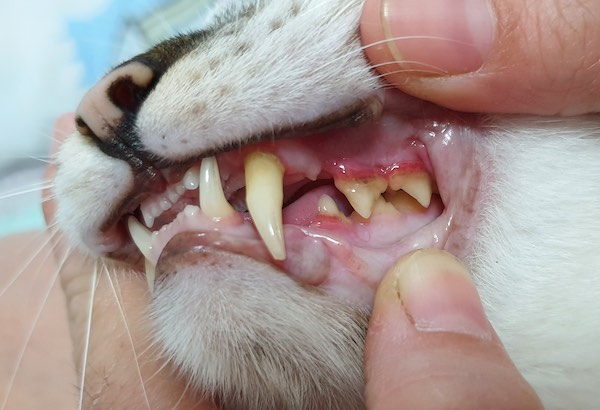
The specific cause of tooth resorption has not been determined despite extensive research. Tooth resorption is most common on the premolars of the lower jaw. Tooth resorption is a progressive painful erosion of the tooth’s enamel, cementum, and dentin. It can affect the crown of the tooth and the root. After a point, the tooth becomes irreparably destroyed. The crown can break off at the gum line, leaving the tooth roots in place. This is just one reason that dental x-rays are essential in identifying non-visible issues. Studies have shown that no obvious lesion was noted in 50% of cases – these were only revealed by the x-rays.
This is a persistent and painful condition that results from severe inflammation of the tissues of the mouth. About 0.7 to 4 % of cats are affected. Unfortunately, the cause of this painful condition is not known. Some beliefs are that there are viral and bacterial aspects and inflammatory diseases involved. There are times when this condition cannot be controlled medically and with regular dental care. In these extreme cases, cats often have to have all their teeth extracted to control the pain and inflammation. Following full mouth extractions, cats do wonderfully well since the source of pain is gone. They can eat just fine without teeth.
If your veterinarian determines that your cat needs a dental cleaning and possibly some extractions, it is critical you follow their advice and recommendations before and after the procedure.
It is important to understand that your veterinarian can only do an initial assessment of your cat's dental issues while they are awake. So, the true extent, as far as periodontal disease, tooth root abscesses, tooth resorption, damaged teeth, etc., cannot be determined until your cat has been anesthetized and dental x-rays are done.
Therefore, it is important to be available by phone while your cat is having their dental procedure because your veterinarian may have to contact you if they find more dental issues than originally suspected.
Following the procedure, be sure to follow your veterinarian’s discharge instructions closely. Depending on how bad your cat’s dental disease was and if extractions were needed, your veterinarian might send your cat home with antibiotics, pain meds, and an oral rinse. Be sure to give all medications as directed, even if your cat does not seem painful, and do not stop or alter their medication in any way without first consulting with your vet.
If your veterinarian provided an oral rinse, use it as directed. The oral rinse often has an angled adaptor you can easily place in the corner of your pet’s mouth and then squeeze the bottle. This is usually done on both sides of the mouth. If your cat doesn’t like the bottle, you can get a syringe from your veterinarian and use that instead. The syringe is often easier to manage, and you can hide it better than the bottle of rinse.
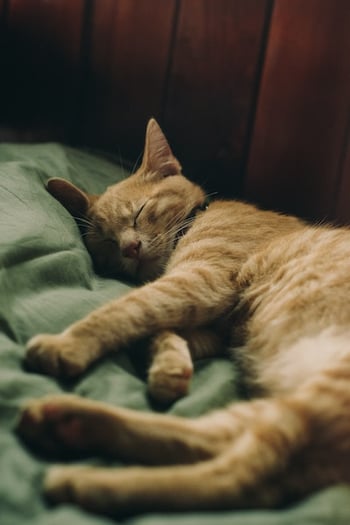
Nausea: Oftentimes, cats can get nauseated from the anesthesia. If your cat has a history of this, be sure to inform your veterinarian so they can provide early relief. If your veterinarian has not given them something pre or post-procedure, be sure to ask them what you can give your cat if they seem nauseated or are vomiting.
To know if your cat is nauseated, they may drool, lick their lips frequently, retch, or gag and they may vomit a watery or greenish liquid.
Grogginess: They could also be groggy from the anesthesia, so providing them a quiet environment to rest upon returning home is critical. Placing a Feliway pheromone diffuser in the area they are resting in can aid in calming them. Move their litter box closer to their resting spot so that your cat doesn't have to move around too much. And be sure to let them rest in a moderate temperature location – neither too warm nor too cool.
Coughing: Your cat may cough from irritation of intubation during the procedure (a tube is passed into the throat and down the trachea to help keep their airway open). If your cat doesn’t seem better within 2 to 3 days of their procedure or their cough is very harsh and constant, contact your veterinarian.
Eating: If your veterinarian says your cat can eat a small meal later in the evening, following the procedure, soften dry food with warm water, or use canned food. Move food and water bowls close to where your cat is resting, so they don’t have to move around much.
Treats and dental care: If your cat just had a dental cleaning and no extractions, you can let give them some crunchy treats about 48 hours later. Additionally, you can begin their at-home dental care at that point as well.
If your cat had extractions done, do not let them crunch on anything hard for about 10 days. This will allow time for the tissue to heal. If your cat had multiple, difficult extractions, your veterinarian may advise you to wait 14 days or recommend your cat not to chew on any hard items in the future. You can also begin your at-home dental care at this time with the approval of your cat’s veterinarian. You do not want to risk opening any places in the gums where they were sutured closed.
Generally, after a basic cleaning, your cat will be back to their normal eating, drinking, and playful selves in about 2 days.
If your cat had extractions in addition to their cleaning, their mouth may be sore for up to a week. But generally, you should notice an improvement about 2 to 4 days following their procedure.
If your cat doesn't want to eat, drink, or acts painful after a 36-hour window has passed following their procedure, contact your veterinarian. They may need additional pain medications or need to be re-evaluated by your vet.
If your cat is vomiting or has diarrhea, contact your veterinarian. Vomiting once or twice in the first 24 hours following the procedure can be a normal response to anesthesia but still contact your veterinarian to let them know. They'll give you some guidance if anything else needs to be done.
If you notice your cat pawing at their face and mouth area, avoiding their head being touched, or they seem painful when eating, contact your veterinarian.

Early intervention is the key to prevention. It is recommended, once yearly for adult cats and twice yearly for senior cats, to have an oral/dental exam by done their veterinarian. This will help identify issues early so that treatment can be initiated before there is further progression of disease.
Within 6 hours after your cat has a cleaning, plaque is already forming
Home dental care is essential in the prevention of dental disease. There are many ways you can help prevent it. To make it a habit, perform dental care prevention daily. Additionally, determine which methods work the best for you and your cat. Often combining two or more helps keep you consistent. The following are some methods you can try at home.
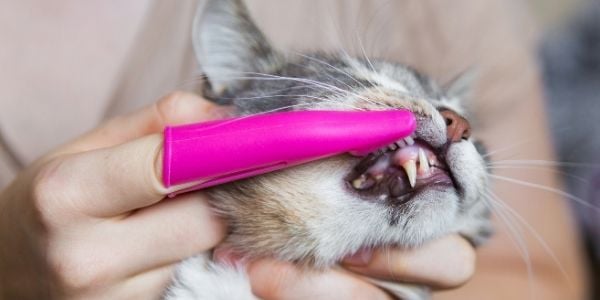
DO NOT USE HUMAN TOOTHPASTE. Their ingredients are not meant to be swallowed. They contain too much fluoride and other ingredients that may be harmful to cats. Pet toothpaste is safe to swallow, does not foam, and the flavors are more enjoyable for animals. Additionally, they contain enzymes that aid in the breakdown of plaque. Your veterinarian can make some recommendations. For cats who hate to have their teeth brushed, you can try Oratene Brushless Toothpaste Gel.
Do not use baking soda. It can upset their stomach and digestive tract if swallowed because of its high alkaline content.
Try to brush daily but at the very least every 2–3 days. Something is better than nothing. Even just rubbing a cotton swab on the teeth is effective in helping control plaque. To make your cat enjoy this process more, you can dip the swab in tuna water.
This video explains how to brush your cat's teeth.
There are special dental diets that add in the prevention of the accumulation of plaque and tartar. Some even help with gingivitis (inflamed gums) and halitosis (bad breath). Some options include Royal Canine Veterinary Dental Diet, Purina Pro Plans Veterinary Diets DH, and Hill’s Prescription t/d dental diet.
As long as your cat has no food allergies or digestive issues, you can give them dental treats that have the VOHC (Veterinary Oral Health Council) seal on them. Only those treats that have this seal have been proven to reduce the accumulation of plaque and tartar. To obtain the seal, the product must pass strict scientific studies. If you go to VOHC.org, you can find a list of accepted products. Your veterinarian can also be a source of recommendations.
There are food and water additives that aid in reducing plaque and tartar build-up as well. A good food additive is VetriScience Perio powder, and Oratene makes a water additive for pets.
For cats with severe periodontal disease, you can talk with your veterinarian about Oratene Oral Antiseptic gel. This product contains a potent enzyme that aids in the treatment of gingivitis and periodontal disease. It soothes and relieves inflamed gums. By not having to touch painful gums with a brush, your cat will be more willing to allow the treatment.
As always, consult with your cat’s veterinarian for additional guidance on ways to help prevent dental disease.
The Pet InfoRx® is made possible, in part, through our partnership with AlignCare®.
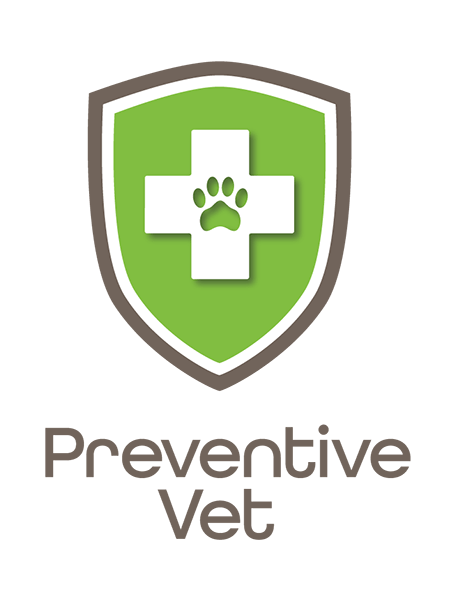

© Preventive Vet. All rights reserved. PreventiveVet.com
